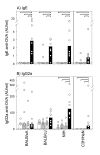The allergy adjuvant effect of particles - genetic factors influence antibody and cytokine responses
- PMID: 15967044
- PMCID: PMC1182367
- DOI: 10.1186/1471-2172-6-11
The allergy adjuvant effect of particles - genetic factors influence antibody and cytokine responses
Abstract
Background: There is increasing epidemiological and experimental evidence for an aggravating effect of particulate air pollution on asthma and allergic symptoms and, to a lesser extent, on allergic sensitization. Genetic factors appear to influence not only the magnitude, but also the quality of the adjuvant effect of particles with respect to allergen-specific IgE (Th2-associated) and IgG2a (Th1-associated) responses. In the present study, we aimed to investigate how the genetic background influences the responses to the allergen and particles alone and in combination. We examined how polystyrene particles (PSP) affected the IgE and IgG2a responses against the model allergen ovalbumin (OVA), after subcutaneous injection into the footpad of BALB/cA, BALB/cJ, NIH and C3H/HeN mice, Further, ex vivo IL-4, IFN-gamma and IL-10 cytokine secretion by Con A-stimulated cells from the draining popliteal lymph node (PLN) five days after injection of OVA and PSP separately or in combination was determined.
Results: PSP injected with OVA increased the levels of OVA-specific IgE antibodies in all strains examined. In contrast, the IgG2a levels were significantly increased only in NIH and C3H/HeN mice. PSP in the presence of OVA increased cell numbers and IL-4, IL-10 and IFN-gamma levels in BALB/cA, NIH and C3H/HeN mice, with the exception of IFN-gamma in NIH mice. However, each mouse strain had their unique pattern of response to OVA+PSP, OVA and PSP, and also their unique background cytokine response (i.e. the cytokine response in cells from mice injected with buffer only).
Conclusion: Genetic factors (i.e. the strain of mice) influenced the susceptibility to the adjuvant effect of PSP on both secondary antibody responses and primary cellular responses in the lymph node, as well as the cellular responses to both OVA and PSP given separately. Interestingly, PSP alone induced cytokine responses in the lymph node in some of the mouse strains. Furthermore, we found that the ex vivo cytokine patterns did not predict the in vivo Th2- and Th1-associated antibody response patterns in the different mouse strains. The results indicate that insoluble particles act by increasing the inherent response to the allergen, and that the genetic background may determine whether an additional Th1-associated component is added to the response.
Figures



Similar articles
-
The IgE adjuvant effect of particles: characterisation of the primary cellular response in the draining lymph node.Toxicology. 2005 Jan 15;206(2):181-93. doi: 10.1016/j.tox.2004.07.018. Toxicology. 2005. PMID: 15588912
-
The adjuvant effect of particles-importance of genetic background and pre-sensitisation.Int Arch Allergy Immunol. 2000 Jul;122(3):167-73. doi: 10.1159/000024393. Int Arch Allergy Immunol. 2000. PMID: 10899759
-
Diesel exhaust, carbon black, and silica particles display distinct Th1/Th2 modulating activity.Toxicol Appl Pharmacol. 2000 Oct 15;168(2):131-9. doi: 10.1006/taap.2000.9013. Toxicol Appl Pharmacol. 2000. PMID: 11032768
-
Deviation of the allergic IgE to an IgG response by gene immunotherapy.Int Rev Immunol. 1999;18(3):271-89. doi: 10.3109/08830189909043030. Int Rev Immunol. 1999. PMID: 10614729 Review.
-
Assessment of the inherent allergenic potential of proteins in mice.Environ Health Perspect. 2003 Feb;111(2):227-31. doi: 10.1289/ehp.5703. Environ Health Perspect. 2003. PMID: 12573911 Free PMC article. Review.
Cited by
-
Particulate adjuvant and innate immunity: past achievements, present findings, and future prospects.Int Rev Immunol. 2013 Apr;32(2):209-20. doi: 10.3109/08830185.2013.773326. Int Rev Immunol. 2013. PMID: 23570316 Free PMC article. Review.
-
Antiviral potential of nanoparticles for the treatment of Coronavirus infections.J Trace Elem Med Biol. 2022 Jul;72:126977. doi: 10.1016/j.jtemb.2022.126977. Epub 2022 Mar 26. J Trace Elem Med Biol. 2022. PMID: 35397331 Free PMC article. Review.
-
Exploring the Potential Effects and Mechanisms of Asarum sieboldii Radix Essential Oil for Treatment of Asthma.Pharmaceutics. 2022 Mar 3;14(3):558. doi: 10.3390/pharmaceutics14030558. Pharmaceutics. 2022. PMID: 35335934 Free PMC article.
-
Investigations of immunogenic, allergenic and adjuvant properties of Cry1Ab protein after intragastric exposure in a food allergy model in mice.BMC Immunol. 2016 May 4;17(1):10. doi: 10.1186/s12865-016-0148-x. BMC Immunol. 2016. PMID: 27141950 Free PMC article.
-
Compartmental and temporal dynamics of chronic inflammation and airway remodelling in a chronic asthma mouse model.PLoS One. 2014 Jan 21;9(1):e85839. doi: 10.1371/journal.pone.0085839. eCollection 2014. PLoS One. 2014. PMID: 24465740 Free PMC article.
References
-
- Brunekreef B, Sunyer J. Asthma, rhinitis and air pollution: is traffic to blame? Eur Respir J. 2003;21:913–915. - PubMed
-
- Lippmann M, Frampton M, Schwartz J, Dockery D, Schlesinger R, Koutrakis P, Froines J, Nel A, Finkelstein J, Godleski J, Kaufman J, Koenig J, Larson T, Luchtel D, Liu LJ, Oberdorster G, Peters A, Sarnat J, Sioutas C, Suh H, Sullivan J, Utell M, Wichmann E, Zelikoff J. The U.S. Environmental Protection Agency Particulate Matter Health Effects Research Centers Program: a midcourse report of status, progress, and plans. Environ Health Perspect. 2003;111:1074–1092. - PMC - PubMed
-
- Nel AE, Diaz-Sanchez D, Ng D, Hiura T, Saxon A. Enhancement of allergic inflammation by the interaction between diesel exhaust particles and the immune system. J Allergy Clin Immunol. 1998;102:539–554. - PubMed
Publication types
MeSH terms
Substances
LinkOut - more resources
Full Text Sources
Other Literature Sources
Molecular Biology Databases
Miscellaneous

